Bollman Bridge (Wernwag Bridge)
Introduction
Text-to-speech Audio
The 1836 Wernwag (or Latrobe) bridge was a wooden covered railroad and highway bridge spanning the Potomac River from Maryland Heights to the Point at Harpers Ferry. Used by the Baltimore & Ohio Railroad, the bridge was destroyed and rebuilt several times during the Civil War. Afterwards, the B&O rebuilt the bridge as the Bollman Iron Truss Bridge. The B&O crossing was known for its sharp turns at either end of the bridge, which ultimately led to the railroad realigning their tracks and constructing a new bridge adjacent to this one. The Bollman bridge served as a highway bridge until it was destroyed in the 1936 flood.
Images
The covered B&O Railroad Bridge in 1859 (HF-66, Historic Photo Collection, Harpers Ferry NHP)
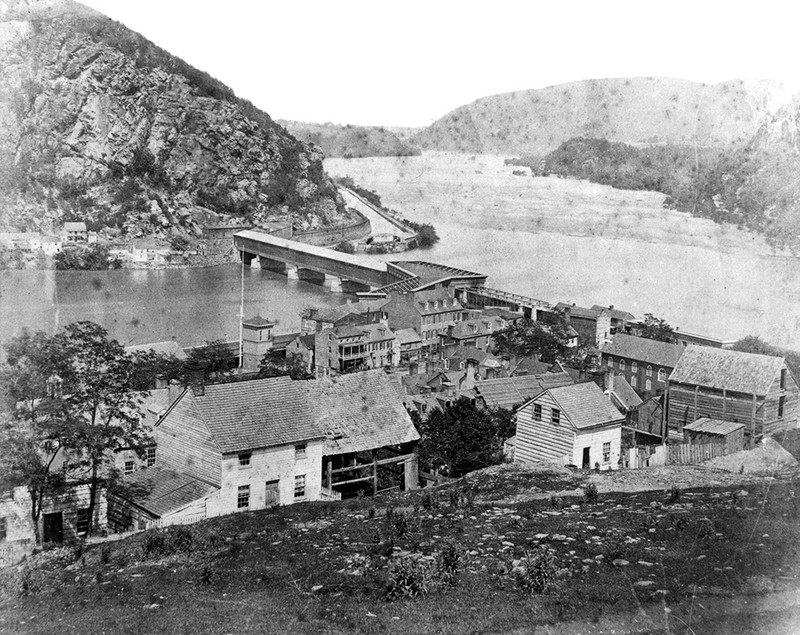
1859 view from the Maryland side. The B&O bridge has wooden sides and a tin roof. (HF-64, Historic Photo Collection, Harpers Ferry NHP)
.jpg)
The B&O Bridge was destroyed by Confederates on June 14, 1861. (LC-B817-7649, Library of Congress)
.jpg)
After the Civil War the B&O erected an entirely iron Bollman Bridge (HF-78, Historic Photo Collection, Harpers Ferry NHP)
.jpg)
"Illustration of the devastating Flood of September 30-October 1, 1870, which took 42 lives in the Harpers Ferry area, from “Harper’s Weekly.” (HF-347, Historic Photo Collection, Harpers Ferry NHP)"
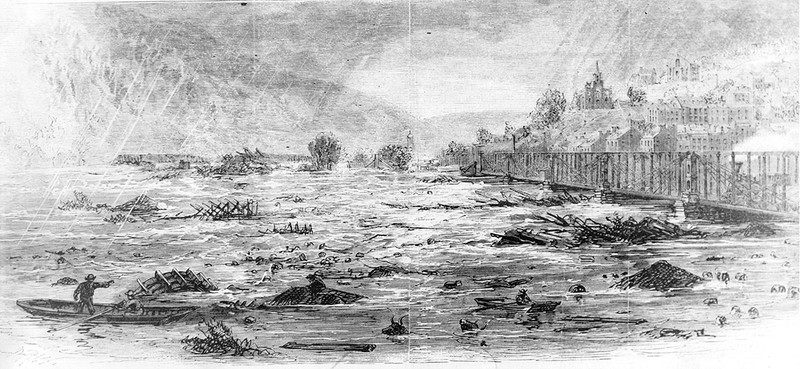
View of the Bollman and Shenandoah Bridges (undated postcard)

Flood of June 1, 1889: The Bollman Bridge survived but the damage to the Shenandoah Bridge is visible. (HF-615, Historic Photo Collection, Harpers Ferry NHP)
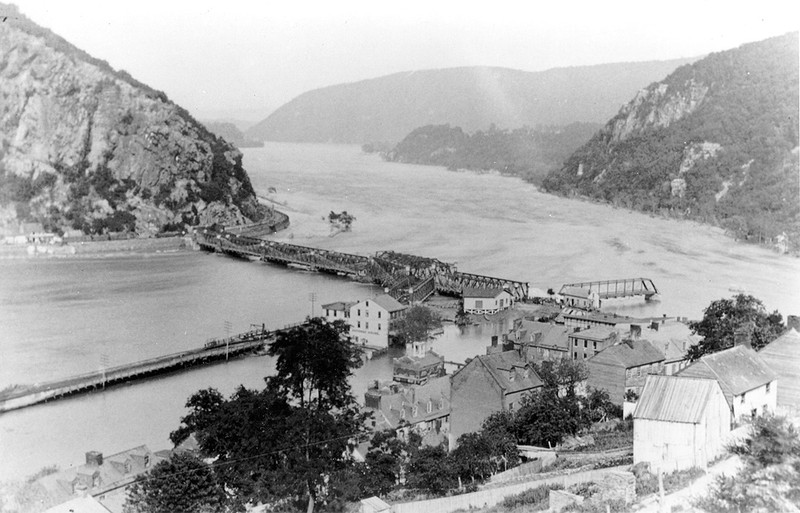
After 1894 the Bollman Bridge was for highway traffic only. The tunnel visible in the background was part of the realignment of the B&O railroad tracks with a new bridge. (HF-1191, Historic Photo Collection, Harpers Ferry NHP)
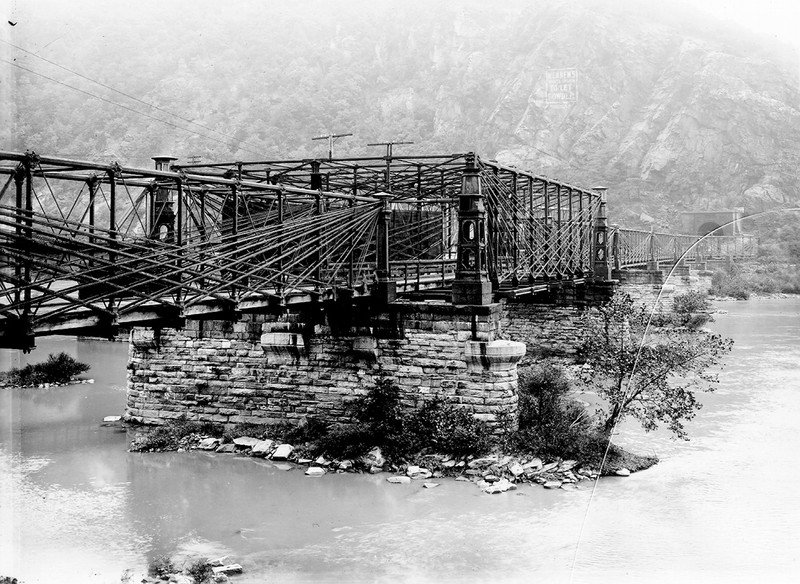
Postcard with c.1905 view of the Bollman Bridge and B&O Bridge
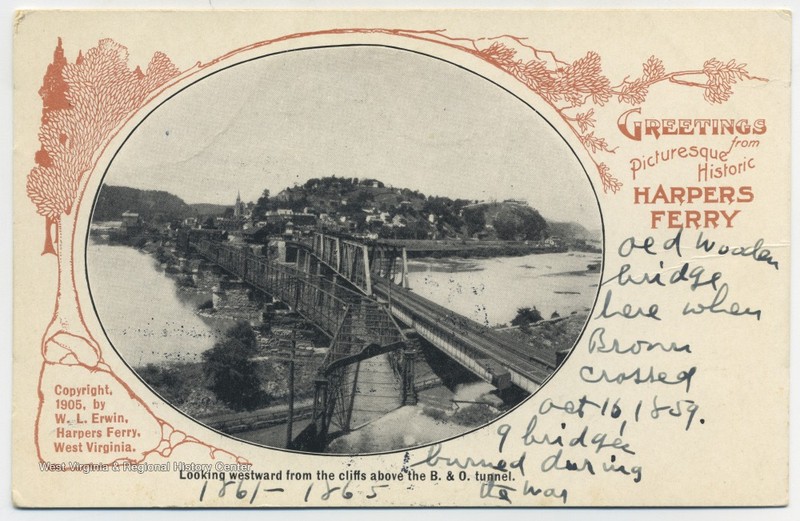
1905 postcard of the view from Maryland Heights
.jpg)
c. 1905 postcard of the bridges across the Potomac.
.jpg)
1906 image of the Bollman Bridge (middle) with the B&O Bridge (right) and Shenandoah Bridge (left).
.jpg)
Flooding was a constant problem for Harpers Ferry and the 1924 flood damaged several sections of the Bollman Bridge. Three steel spans replaced the damaged sections by 1933. (HF-833, Historic Photo Collection, Harpers Ferry NHP)
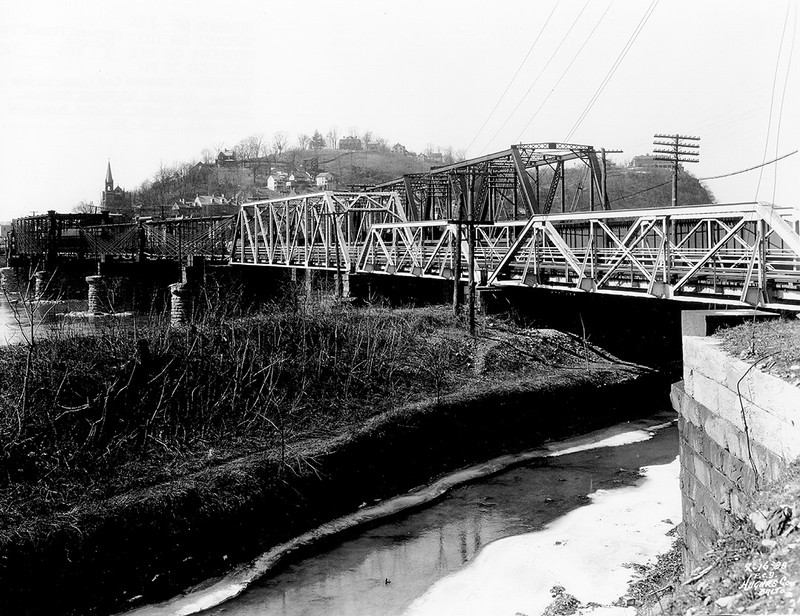
1933 view of the Bollman Bridge and tool gate (HF-835, Historic Photo Collection, Harpers Ferry NHP)
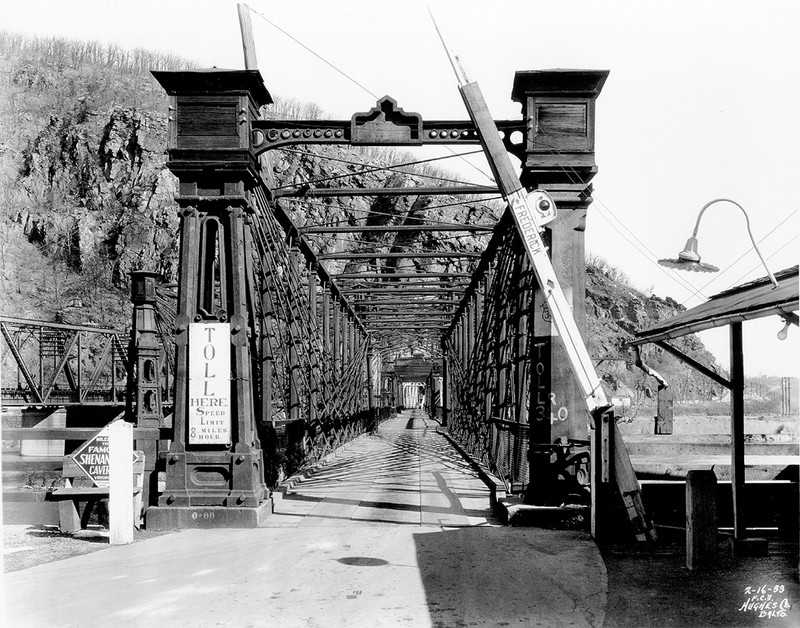
1931 aerial showing the Bollman Bridge with the two newer B&O railroad bridges. The fourth bridge on the right is the Shenandoah (highway) bridge. (HF-5, Historic Photo Collection, Harpers Ferry NHP)
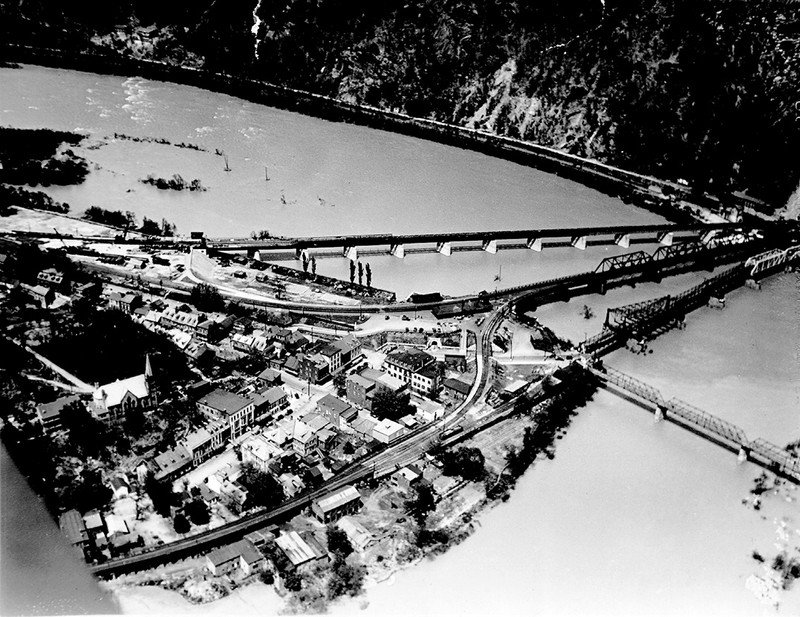
1931 aerial shot of all four Harpers Ferry bridges (HF-289, Historic Photo Collection, Harpers Ferry NHP)
.jpg)
Flood of 1936: This March 18 photo shows the floodwaters rising, prior to the bridges being damaged. (HF-1726, Historic Photo Collection, Harpers Ferry NHP)
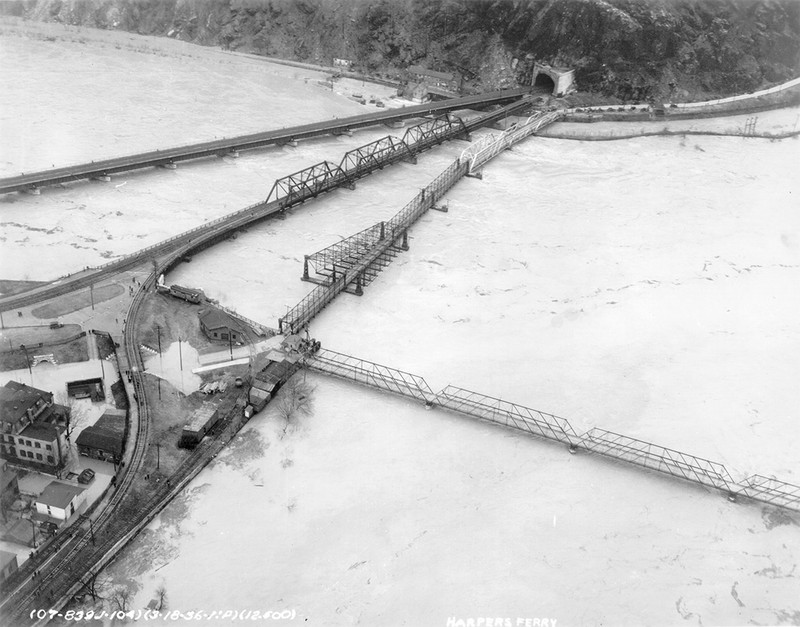
Flood of 1936: In this March 19 photo the Bollman and Shenandoah Bridges have been destroyed and the remaining two bridges have been loaded with coal cars to try to keep them in place. (HF-1724, Historic Photo Collection, Harpers Ferry NHP)
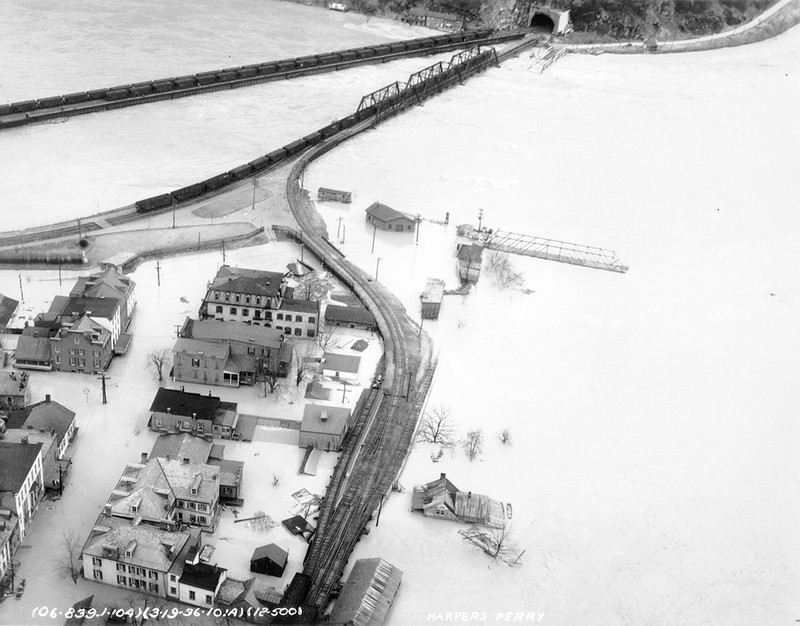
Flood of 1936: The B&O Railroad Bridge with loaded coal cars. The last standing piece of the Bollman Bridge is visible in the far left of the photo. (HF-1724, Historic Photo Collection, Harpers Ferry NHP)
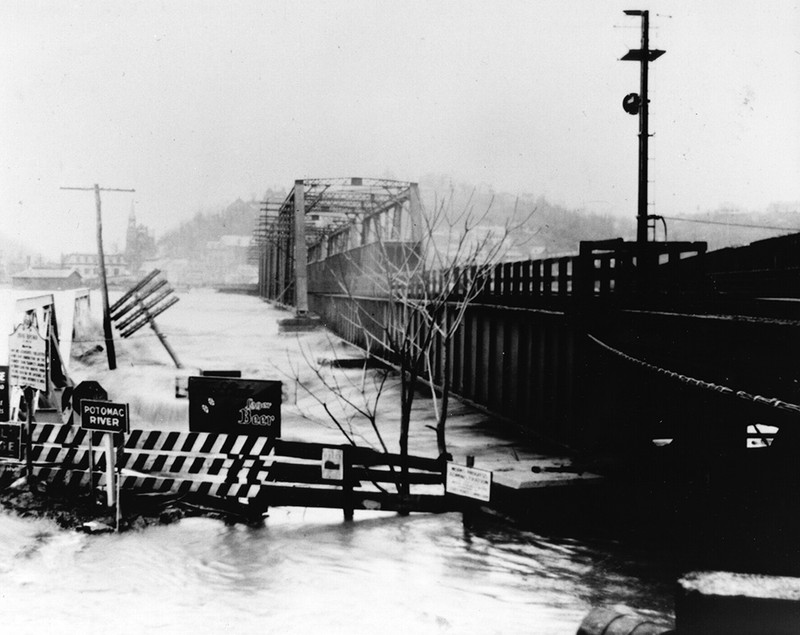
Flood 1936: After the floodwaters receded, the damage to the Bollman and Shenandoah Bridges was fully visible. (HF-1219, Historic Photo Collection, Harpers Ferry NHP)
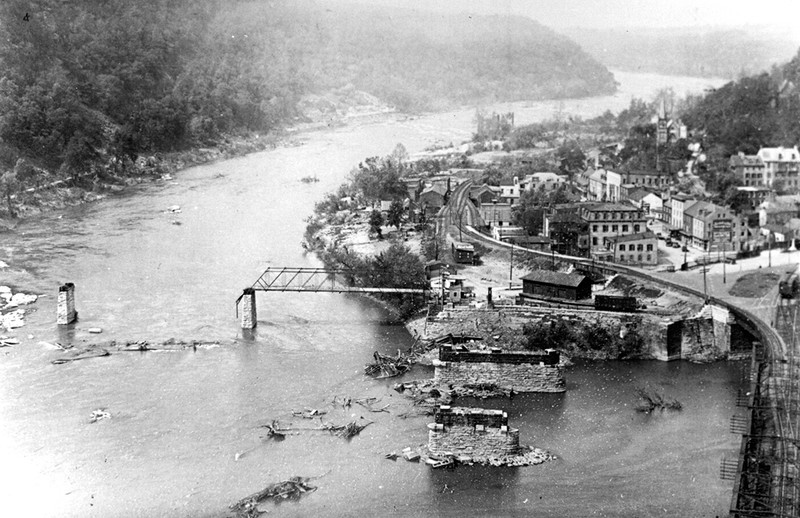
Title Sheet, South Elevation, Location Map - Baltimore & Ohio Railroad, Bollman Bridge, Spanning Potomac River at Harpers Ferry, Harpers Ferry, Jefferson County, WV Drawings from Survey HAER WV-36

Site Plan, Pier A - Baltimore & Ohio Railroad, Bollman Bridge, Spanning Potomac River at Harpers Ferry, Harpers Ferry, Jefferson County, WV Drawings from Survey HAER WV-36
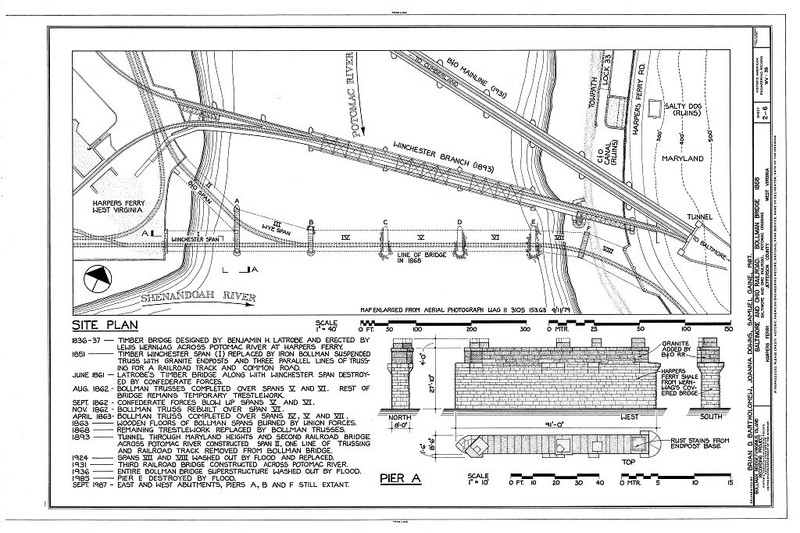
Section A-A, Panel Spacer, Post Base, Diagonal Retainer, Post Head - Baltimore & Ohio Railroad, Bollman Bridge, Spanning Potomac River at Harpers Ferry, Harpers Ferry, Jefferson County, WV Drawings from Survey HAER WV-36
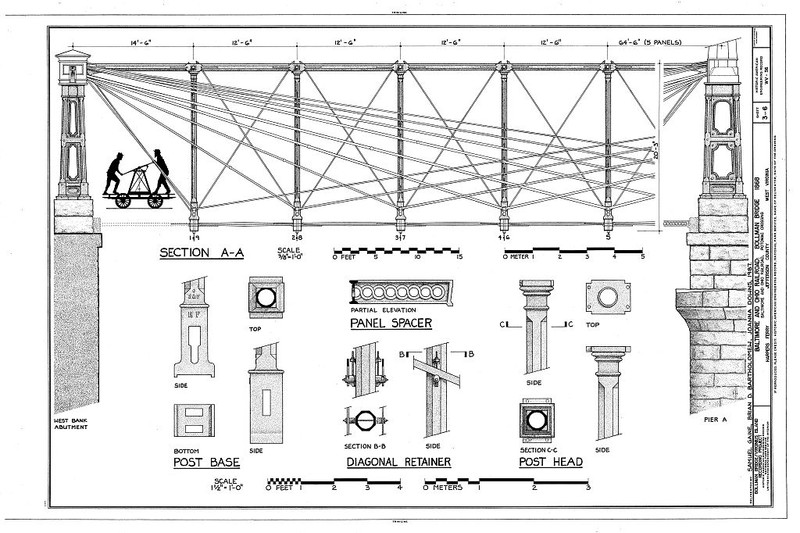
Anchor Casting and Portal Strut at West Bank Abutment, Endpost Base and Granite Plinth - Baltimore & Ohio Railroad, Bollman Bridge, Spanning Potomac River at Harpers Ferry, Harpers Ferry, Jefferson County, WV Drawings from Survey HAER WV-36.
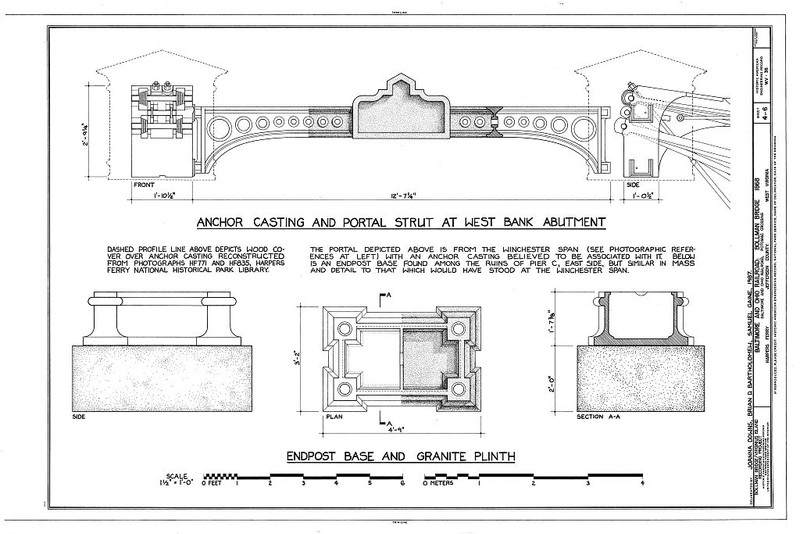
Winchester Span Isometric, Post 1893 - Baltimore & Ohio Railroad, Bollman Bridge, Spanning Potomac River at Harpers Ferry, Harpers Ferry, Jefferson County, WV Drawings from Survey HAER WV-36.
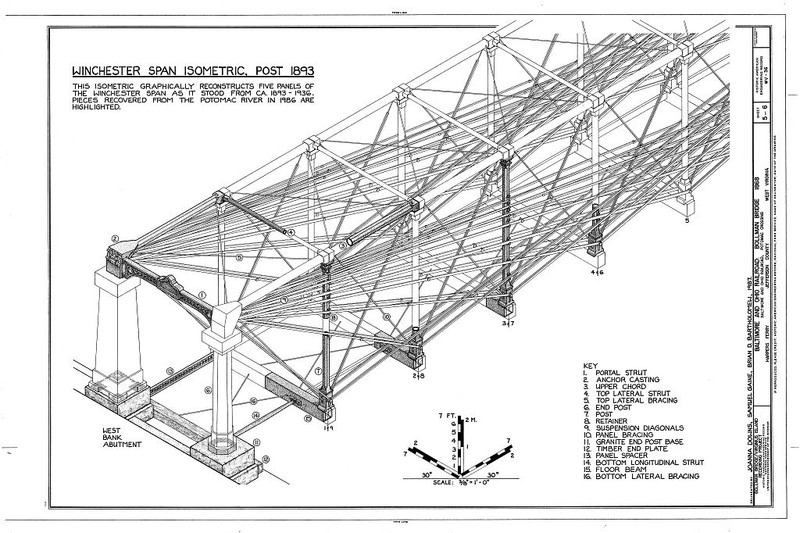
Winchester Span Isometric Anchor Casting and Post 1 & 9 Head, Winchester Span Exploded Isometric Typical Post Base and Floor Beam - Baltimore & Ohio Railroad, Bollman Bridge, Spanning Potomac River at Harpers Ferry, Harpers Ferry, Jefferson County, WV Drawings from Survey HAER WV-36.
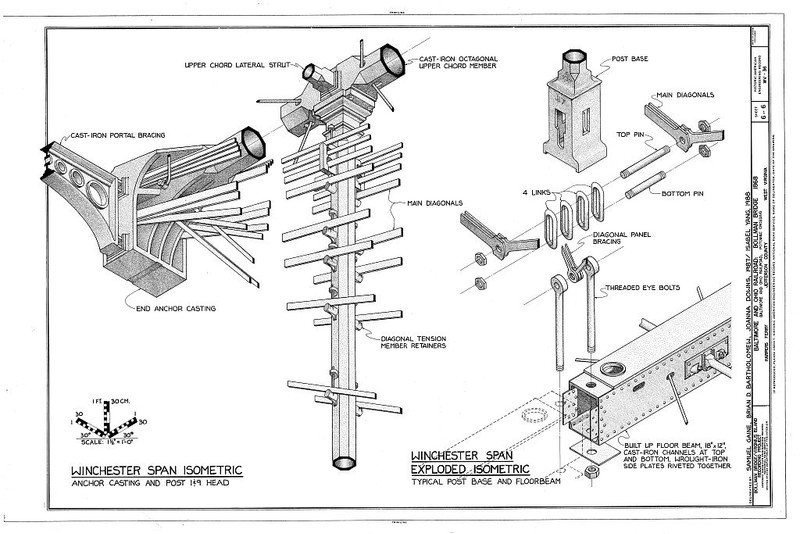
Backstory and Context
Text-to-speech Audio
Almost immediately after Robert Harper settled what became the town of Harpers Ferry, he started a ferry between the Point and Maryland Heights to facilitate transportation across the Potomac River. Later, in 1824, a highway bridge was constructed around the same location.
In 1836, the Baltimore & Ohio Railroad came to Harpers Ferry, first connecting to the Winchester & Potomac Line and then constructing a new line to connect to Cumberland, MD. The arrival of the B&O led to the construction of the Wernwag, or Latrobe, Bridge. The wooden bridge was designed by the Chief Engineer for the B&O Railroad, Benjamin H. Latrobe, and served as a combination railroad and highway/toll bridge between Maryland Heights and Harpers Ferry. Construction was overseen by a local builder, Lewis Wernwag, and the bridge was most commonly known as the Wernwag Bridge. The original B&O crossing was infamous for the tight curves at both ends of the bridge. The steep rise of Maryland Heights on the one side and the layout of the town and armory at Harpers Ferry meant that on both sides of the river the railroad tracks were practically parallel to the Potomac and then had to turn to cross at the railroad bridge. Economically, the B&O wanted to construct the shortest possibly bridge, which led to its placement at the Point with almost right-angled turns at either end. The Wernwag Bridge was a wooden covered bridge that was repaired several times between 1836 and 1851. Because the Wager family of Harpers Ferry still owned the land at the Point, they were able to collect tolls from vehicle traffic across the bridge (although they had an agreement with the B&O not to collect tolls on railroad traffic).
In 1851, the B&O replaced one section of the span with a new iron design by Wendel Bollman. The rest of the bridge remained in the original covered wooden design until the Civil War. In June 1861 the B&O Railroad Bridge was destroyed by Confederate forces leaving Harpers Ferry. Since Harpers Ferry was such an important strategic point for the movement of both armies (and the civilian population of the surrounding areas) the bridge was rebuilt and destroyed several times between 1861 and 1865. After the Civil War the B&O had to rebuild a permanent bridge and they decided to keep the same alignment due to the costs of realigning the tracks. Instead of rebuilding a wooden bridge, the railroad decided to do an entire iron span of the Bollman design. Like the Wernwag Bridge, the Bollman Iron Truss Bridge was also a combination railroad and toll bridge until the 1890s.
Eventually the B&O Railroad had to address the tight turns on both sides of the Harpers Ferry Bridge and the neighboring steel truss bridge was constructed in 1894 to adjust the alignment of the tracks (this was in combination with the new tunnel through Maryland Heights and moving the tracks through the original armory grounds). The Bollman Bridge continued in use as a pedestrian and vehicle bridge under the administration of the Harpers Ferry and Potomac Bridge Co. In the twentieth century, with the growth of automobile traffic, State Route 340 used the Bollman Bridge (Harpers Ferry Bridge) to cross the Potomac.
The Bollman Bridge was destroyed in the flood of 1936 that also destroyed the neighboring Shenandoah Bridge and caused considerable damage in Harpers Ferry. After that the bridge was never rebuilt, leaving only the six stone piers and two stone abutments. As of 1999 pieces of the iron Bollman Bridge could be seen in periods of extremely low water.
The piers were originally included in the National Register listing “Baltimore and Ohio Railroad Crossing of the Potomac River between Maryland Heights, Maryland and Harpers Ferry, West Virginia.” In 1992 the piers were acquired by the National Park Service and are now listed under the Harpers Ferry National Historical Park on the National Register of Historic Places.
Sources
"National Register of Historic Places Inventory--Nomination: Baltimore and Ohio Railroad Crossing of the Potomac River between Maryland Heights, Maryland and Harpers Ferry, West Virginia." Accessed August 17, 2021.
"National Register of Historic Places Registration Form: Bollman Bridge, Wernwag or Latrobe Bridge." Accessed August 17, 2021. http://www.wvculture.org/shpo/nr/pdf/jefferson/02000287.pdf.
"Baltimore & Ohio Railroad Bridges." Dave Gilbert Graphic Design. Accessed August 17, 2021. http://www.dgilbert53.net/?page_id=871.
"Baltimore & Ohio Railroad Bridges." Dave Gilbert Graphic Design. Accessed August 17, 2021. http://www.dgilbert53.net/?page_id=871.
"Baltimore & Ohio Railroad Bridges." Dave Gilbert Graphic Design. Accessed August 17, 2021. http://www.dgilbert53.net/?page_id=871.
"Baltimore & Ohio Railroad Bridges." Dave Gilbert Graphic Design. Accessed August 17, 2021. http://www.dgilbert53.net/?page_id=871.
"Floods at Harpers Ferry." Dave Gilbert Graphic Design. Accessed August 18, 2021. http://www.dgilbert53.net/?page_id=832.
"Where Three States Meet on Baltimore and Ohio Railroad; Harpers Ferry, W. Va." West Virginia History OnView. West Virginia & Regional History Center. Accessed August 17, 2021. https://www.wvhistoryonview.org/catalog/042640.
"Floods at Harpers Ferry." Dave Gilbert Graphic Design. Accessed August 18, 2021. http://www.dgilbert53.net/?page_id=832.
"Baltimore & Ohio Railroad Bridges." Dave Gilbert Graphic Design. Accessed August 17, 2021. http://www.dgilbert53.net/?page_id=871.
"Harpers Ferry Looking Westward; Harpers Ferry, W. Va." West Virginia History OnView. West Virginia & Regional History Center. Accessed August 17, 2021. https://www.wvhistoryonview.org/catalog/042641.
"Looking Across Potomac From Cliffs of Maryland Heights; Harper's Ferry, W. Va." West Virginia History OnView. West Virginia & Regional History Center. Accessed August 17, 2021. https://www.wvhistoryonview.org/catalog/042637.
"The Gap at Harpers Ferry, W. Va." West Virginia History OnView. West Virginia & Regional History Center. Accessed August 17, 2021. https://www.wvhistoryonview.org/catalog/042636.
"Harpers Ferry From Maryland Heights; Harpers Ferry, W. Va." West Virginia History OnView. West Virginia & Regional History Center. Accessed August 17, 2021. https://www.wvhistoryonview.org/catalog/042632.
"Baltimore & Ohio Railroad Bridges." Dave Gilbert Graphic Design. Accessed August 17, 2021. http://www.dgilbert53.net/?page_id=871.
"Baltimore & Ohio Railroad Bridges." Dave Gilbert Graphic Design. Accessed August 17, 2021. http://www.dgilbert53.net/?page_id=871.
"Baltimore & Ohio Railroad Bridges." Dave Gilbert Graphic Design. Accessed August 17, 2021. http://www.dgilbert53.net/?page_id=871.
"Baltimore & Ohio Railroad Bridges." Dave Gilbert Graphic Design. Accessed August 17, 2021. http://www.dgilbert53.net/?page_id=871.
"Floods at Harpers Ferry." Dave Gilbert Graphic Design. Accessed August 18, 2021. http://www.dgilbert53.net/?page_id=832.
"Floods at Harpers Ferry." Dave Gilbert Graphic Design. Accessed August 18, 2021. http://www.dgilbert53.net/?page_id=832.
"Floods at Harpers Ferry." Dave Gilbert Graphic Design. Accessed August 18, 2021. http://www.dgilbert53.net/?page_id=832.
"Floods at Harpers Ferry." Dave Gilbert Graphic Design. Accessed August 18, 2021. http://www.dgilbert53.net/?page_id=832.
Historic American Engineering Record, Creator. Baltimore & Ohio Railroad, Bollman Bridge, Spanning Potomac River at Harpers Ferry, Harpers Ferry, Jefferson County, WV. Jefferson County Harpers Ferry West Virginia, 1968. Documentation Compiled After. Photograph. https://www.loc.gov/item/wv0291/. Accessed August 17, 2021.
Historic American Engineering Record, Creator. Baltimore & Ohio Railroad, Bollman Bridge, Spanning Potomac River at Harpers Ferry, Harpers Ferry, Jefferson County, WV. Jefferson County Harpers Ferry West Virginia, 1968. Documentation Compiled After. Photograph. https://www.loc.gov/item/wv0291/. Accessed August 17, 2021.
Historic American Engineering Record, Creator. Baltimore & Ohio Railroad, Bollman Bridge, Spanning Potomac River at Harpers Ferry, Harpers Ferry, Jefferson County, WV. Jefferson County Harpers Ferry West Virginia, 1968. Documentation Compiled After. Photograph. https://www.loc.gov/item/wv0291/. Accessed August 17, 2021.
Historic American Engineering Record, Creator. Baltimore & Ohio Railroad, Bollman Bridge, Spanning Potomac River at Harpers Ferry, Harpers Ferry, Jefferson County, WV. Jefferson County Harpers Ferry West Virginia, 1968. Documentation Compiled After. Photograph. https://www.loc.gov/item/wv0291/. Accessed August 17, 2021.
Historic American Engineering Record, Creator. Baltimore & Ohio Railroad, Bollman Bridge, Spanning Potomac River at Harpers Ferry, Harpers Ferry, Jefferson County, WV. Jefferson County Harpers Ferry West Virginia, 1968. Documentation Compiled After. Photograph. https://www.loc.gov/item/wv0291/. Accessed August 17, 2021.
Historic American Engineering Record, Creator. Baltimore & Ohio Railroad, Bollman Bridge, Spanning Potomac River at Harpers Ferry, Harpers Ferry, Jefferson County, WV. Jefferson County Harpers Ferry West Virginia, 1968. Documentation Compiled After. Photograph. https://www.loc.gov/item/wv0291/. Accessed August 17, 2021.
